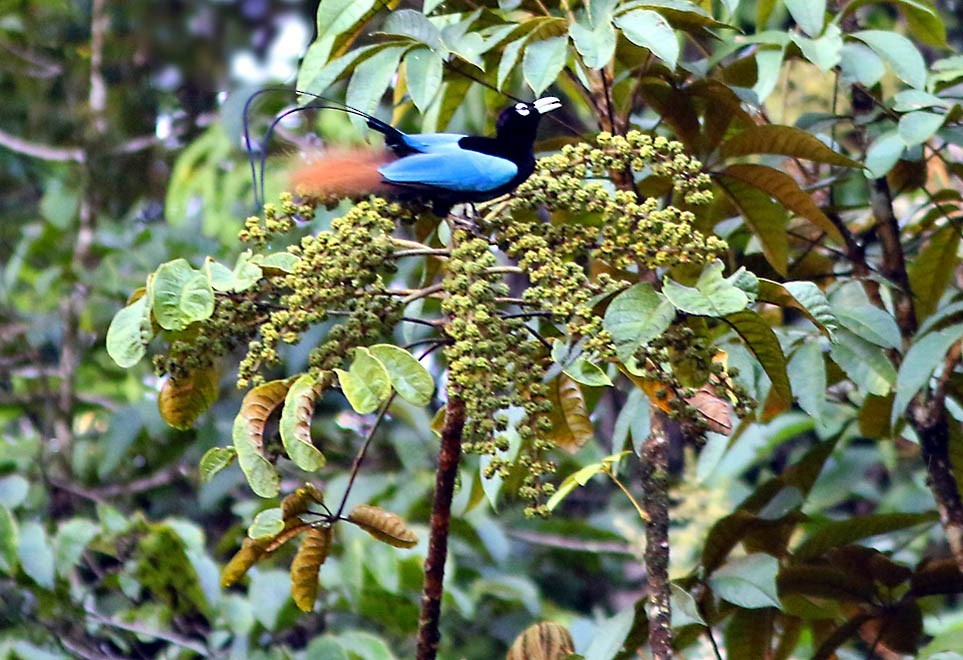Blue Bird-of-paradise
A species of Paradisaea birds-of-paradise Scientific name : Paradisornis rudolphi Genus : Paradisaea birds-of-paradise
Blue Bird-of-paradise, A species of Paradisaea birds-of-paradise
Botanical name: Paradisornis rudolphi
Genus: Paradisaea birds-of-paradise
Content
Description General Info
 Photo By Don Roberson
Photo By Don Roberson Description
Arguably one of the most fabulous of its family, the blue bird-of-paradise is among the larger birds-of-paradise, being around 30 cm, or a little over a foot in length (excluding the long tail wires), rivaling some of the Paradisaea and Manucodia species. Unlike the Paradisaea birds, the male is mostly glossy black overall with silver-white crescents surrounding the eyes (in both sexes). They have a very crow-like bill that is whiteish to light greyish in color. The back of the head has a reddish gloss that stretches down to the mantle, or back. A defining feature found in both sexes are the shiny, blue wings that are more commonly light blue but can range from light blue, aqua or even a skyish-baby blue; the tail is also like this. Stretching from the tail are two blackish and elongated wires with small, whitish spatulate tips similar Paradisaea males' wires. The most brilliant and distinctive feature present on the male are the fine, silky elongated flank plumes that are mainly a dull amber color on the surface; below, they are a light blue, based by two dark crimson lines on each side of the lower belly. These elegant features help the male create an illusion for his potential audience. The female, however, is more or less similar to the male; of course, she lacks the opulent flank plumes and tail wires present on the male, but she does sport bright blue wings and tail feathers like the male. Instead of having an all-black underside, she is chestnut-brown below with blackish barring. Her head and neck are more duller also, with only a faint reddish gloss present. They have purplish-grey legs and feet and greyer claws. the wires on the blue bird-of-paradise are 25 inches long. 
Size
30 cm
Nest Placement
Tree
Feeding Habits
Blue Bird-of-paradise predominantly eats fruits such as figs, berries, and drupes, but also consumes insects and possibly reptiles. Typically solitary feeders, blue Bird-of-paradise forage in the canopy for fruits and descend lower for animal prey, with females and juveniles occasionally joining other birds.
Habitat
The blue Bird-of-paradise thrives in lower montane forests, including forest edges and areas of denser secondary growth that have regrown after agricultural use. These birds typically inhabit regions characterized by lush, mature vegetation, often found in the mountainous terrains where such forest types are prevalent.
Dite type
Frugivorous
General Info
Feeding Habits
Bird food type

Fruit
Species Status
Due to ongoing habitat loss, limited range, small population size and, in some areas, by hunting for its highly prized plumes, the rare blue bird-of-paradise is classified as Vulnerable on the IUCN Red List of Threatened Species. It is listed on Appendix II of CITES. Its population is thought to have a decreasing trend, estimated to be anywhere from 2,500 to 9,999 individuals. 

 Photo By Don Roberson
Photo By Don Roberson Scientific Classification
Phylum
Chordates Class
Birds Order
Perching birds Family
Birds-of-paradise Species
Blue Bird-of-paradise